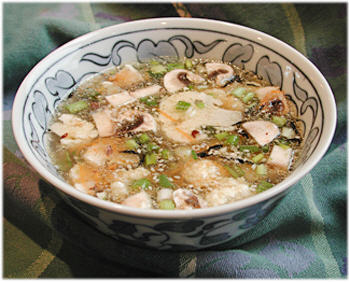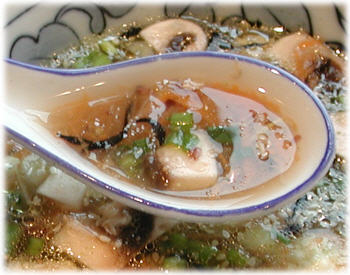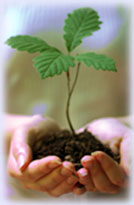 | |
|
Our lives,
so seemingly small, ripple out to the whole universe as tiny whispers like the sounds of butterfly wings, and the clear voice of the living truth. -J.L.D. |

A bowl of soup for lunch—what could be more simple? Especially if it's miso soup. Miso is a traditional fermented food made from various beans and koji.
Now that the weather has turned cold, bowls of soothing and strengthening miso soup warm our bodies and spirits. We enjoy this soup with a combination of freshly grated and chopped veggies, along with a veggie powder that we make (recipe below). Sometimes we include powdered shitake for rich flavor and to boost our immune systems. It's so easy to put a tablespoon of miso into a bowl with shredded veggies, and pour warmed, or hot water on top. Stir, and there you go! Or make larger amounts in a pot. Recipe for Miso Soup::

Ingredients (serves 2):
Try to use all organic ingredients.3 cups pure water 4 tablespoons grated carrot 3 tablespoons green onions, finely chopped 2-3 tablespoons raw, firm, fresh mushrooms (your favorite kind), washed, and finely sliced 2 tablespoons South River Azuki Miso, or your favorite kind (use less if you are salt sensitive) 2 tablespoons daikon radish, super-finely grated 1 tablespoon veggie powder (recipe follows) 2 teaspoons Spectrum walnut or sesame oil 1 teaspoon ginger root, super-finely grated Optional Ingredients:
2-3 tablespoons zucchini or cauliflower, thinly sliced2 tablespoons (or more) favorite seaweed, presoaked 1 tablespoon raw sesame tahini (you won't need the oil from the recipe if you use tahini) 1 clove garlic, peeled and pressed Veggie Powder:
We are always grateful when we have this on hand. It adds so much flavor and nutrition!
However, the miso soup still tastes delicious without it. 3 carrots, scrubbed, tops removed, and chopped 2 stalks celery, rinsed well. Remove any wilted leaves or bad spots. 4 green onions, rinsed and chopped 1/4 cup sweet yellow onion, peeled, rinsed, chopped 1/4 cup parsley, rinsed, chopped Optional Ingredients: Use either 2 kale, chard, or collard leaves, rinsed, and sliced. Put all ingredients into food processor and chop until veggies are minced. Spread veggies onto a dehydrator tray with a Teflex sheet (or use two dinner plates). Place in dehydrator with temperature set to about 105 degrees for 2-3 hours, or until totally dry. Remove from tray or plate, place veggies in a coffee mill or blender and grind until powdery. Put into glass jar with lid. Lasts for weeks, tightly covered. A Little Story: A Living Business... Seven years ago we were reading online about the inspiring story of the founding of South River Miso, the vision of Christian and Gaella Elwell. Their miso, made in the Japanese inaka tradition, is more than a product—it's a way of life, a way of being. We are grateful to them because we can't eat soy products, and they make several varieties (among others) of soy-free, unpasteurized miso, which have become staples in our kitchen. When we first read about what they had accomplished, we thought, How wonderful! What role models! This what we want to do too—yet in our own way. Their hard work and dedication have created a food that is, quite literally, nourishing the world. (Be sure to check out their recipes.)  On the About Us page of their website, they share stories about Noburu Muramoto, who taught them the art of making miso in the traditional ways. And Gaella shares this vivid account that gives the reader a greater understanding of their fortitude and commitment: "That first winter we packed out those 13 tons of miso from our unheated barn and moved it across the South River with draft horses to meet the UPS truck. We found that the high salt content kept the miso from freezing, but not our hands!"
On the About Us page of their website, they share stories about Noburu Muramoto, who taught them the art of making miso in the traditional ways. And Gaella shares this vivid account that gives the reader a greater understanding of their fortitude and commitment: "That first winter we packed out those 13 tons of miso from our unheated barn and moved it across the South River with draft horses to meet the UPS truck. We found that the high salt content kept the miso from freezing, but not our hands!"Christian narrates: "I imagined a way of life I wanted to live on the land in New England: a meaningful, sustainable life, with direct connection to the real sources of our life and being in Spirit, Nature, community, and culture. I thought miso making, as a positive expression of right livelihood, would lend itself to this vision." This poem appears on their site, and speaks directly to our hearts. Food is the vessel of Life. Because Life is another name for God, Food could be called "the vessel of God." If you truly respect and revere the Spirit Then shouldn't the first thing you do Be to build a shrine within your own body? By Eiwan Ishida Genmai, (Tokyo: Japan Pub. 1989) Fermented foods are filled with the friendly bacteria that our bodies need for greater health, and help to awaken us to our interconnection with all things living on the planet. Only life is capable of creating more life, and to us, this is a part of the manifestation of the great Law of Love. Coming next week: Thousand Island Dressing Revisited!  |









